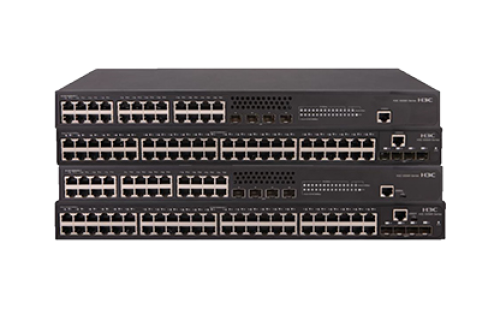
H3C S5560S-SI is the latest development of Gigabit Layer 3 access switch. It’s the second generation intelligent managed switches designed for networks requiring high performance, high port density, high uplink bandwidth and easy to deploy.
H3C S5560S-SI series switch offers Gigabit connectivity with10/100/1000 autosensing ports and 1G or 10G optical uplink.
H3C S5560S-SI series switch includes four models as follows:
S5560S-28P-SI: 24*10/100/1000TX Ethernet ports + 4*SFP ports;
S5560S-52P-SI: 48*10/100/1000TX Ethernet ports + 4*SFP ports;
S5560S-28S-SI: 24*10/100/1000TX Ethernet ports + 4*SFP+ ports;
S5560S-52S-SI: 48*10/100/1000TX Ethernet ports +4*SFP+ ports;
*Warranty Information:Limited Lifetime Warranty Basic 9x5 10BD-Ship service(5Y)
H3C S5560S-SI switch series offers fixed 4-port 10GE or 4-port GE uplink ports which offer high cost effective GE/10GE uplink with high density Gigabit access, protecting customer’s investigation.
H3C S5560S-SI switch series supports Intelligent Resilient Framework 2 (IRF2), which can stack up to 9 models as one logical device, offering high scalability and flexibility.
The S5560S-SI switch series comes with IPv4/IPv6 dual-stack platform which provides hardware-based IPv4/IPv6 wire-speed forwarding and IPv4/IPv6 Layer 3 routing protocols. It also supports IPV6-based ACL, QOS, multicasting and NMS that can help the network upgrade from IPV4 to IPV6.
H3C S5560S-SI switch series is pre-built with Intelligent Resilient Framework 2 (IRF2). IRF2 provides the following benefits:
High scalability: With IRF2, plug-n-play device aggregation can be achieved by adding one or more switches into the IRF2 stack and enabling IRF2 stacking on the new device. New devices can be managed with a single IP, and upgraded at the same time to reduce network expansion cost.
High reliability: The IRF2 patented 1: N backup technology allows each slave device in the IRF2 stack to serve as the backup of the master, creating control and data link redundancy, as well as uninterrupted layer-3 forwarding. This improves the reliability, avoids unplanned business downtime and serves to improve overall performance. When the master device fails, traffic remains uninterrupted.
Load balancing: IRF2 supports cross-device link aggregation, upstream and downstream can be connected to more than one physical link, which creates another layer of network redundancy and boosts the network resource utilization.
Availability: H3C Implements IRF2 through standard Gigabit Ethernet (1GE) ports or 10 Gigabit Ethernet (10GE) ports which allocates bandwidth for business and application access and reasonably splits local traffic and upstream traffic. IRF2 rules not only able to obey within and across the rack, but also across the LAN.
H3C S5560S-SI switch series supports innovative single-port multi-authentication, the access authentication modes supported by different clients are different. For example, some clients can only perform MAC addresses Authentication (such as the printer terminal), and some user host for 802.1X authentication, and some user hosts only want to access through the Web portal authentication. In order to flexibly adapt to the multi-authentication requirements of the network environment, the S5560S-SI switch series support single-port multi-authentication unified deployment.
ARP attack and ARP virus are major threats to LAN security, so the S5560S-SI switch series comes with diverse ARP protection functions such as ARP Detection to challenge the legitimacy of client, validate the ARP packets, and set a speed limit for ARP to prevent ARP swarm attacks from targeting CPU.
H3C S5560S-SI switch series support EAD (End User Admission Domination) function. Once working with the iMC (intelligent Management Centre) system, EAD integrates terminal security policies, such as anti-virus and patch update, into network access control and access right control policies to form a cooperative security system. By checking, isolating, updating, managing, and monitoring access terminals, EAD changes passive, single point network protection to active, comprehensive network protection, and changes separate management to centralized management, enhancing the network capability for preventing viruses, worms, and new threats.
The S5560S-SI switch series supports packet filtering at Layer 2 through Layer 4, and traffic classification based on source MAC addresses, destination MAC addresses, source IP addresses, destination IP addresses, TCP/UDP port numbers, protocol types, and VLANs. It supports flexible queue scheduling algorithms based on ports and queues, including strict priority (SP), weighted round Robin (WRR) and SP+WRR. The S5560S-SI switch series enables committed access rate (CAR) with the minimum granularity of 8 kbps. It supports port mirroring in the outbound and inbound directions, to monitor the packets on the specific ports, and to mirror the packets to the monitor port for network detection and troubleshooting.
The H3C S5560S-SI switch series makes switch management with ease with the support of SNMPv1/v2/v3, which can be managed by NM platforms, such as Open View and iMC. With CLI and Telnet switch management is made easier. And with SSH 2.0 encryption, switch management security is enhanced.
The switch offers the following hardware high availability features:
Automatically monitors power module and fan tray status, and generates alarms when a power or temperature event occurs.
Adjusts fan speed based on the change in temperature.
Self-protection mechanisms that protect power modules against overcurrent, overvoltage, and over-temperature conditions.
In addition to hardware redundancy, the switch provides a variety of node and link redundancy and protection mechanisms, including:
Ethernet link aggregation, including LACP.
Spanning tree protocols, including STP, RSTP and MSTP.
IRF 2 in daisy or ring topology in conjunction with multi-chassis link aggregation.